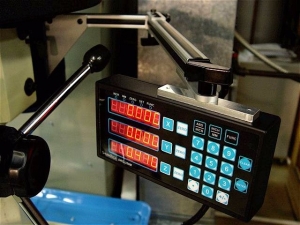
Small wood lathes don’t typically come with an RPM readout, so after obtaining such a machine several months ago, engineer Zach — also known as ‘byte sized’ — decided to build his own custom display.
The device uses a Nano for control, along with a Hall effect sensor to pick up on four magnets attached to the spinning handwheel.

This is consistent with 'perfect' DRO scales and a perfect-when-new lead screw on the mill that has 0.002' of backlash at one end of the travel. Since this was good enough for my purposes, and since it was within the claimed specs of the DRO as well as the accuracy of the test I did, I did not try to check it better than that at that time. 3 Responses to “A DIY digital readout for your wood lathe” Jawss Says: February 16th, 2020 at 11:58:26. I saw the video d.y.i. Lathe DRO and being an almost 75 yrs. Old wood Turner I am very interested. US$286.64 US$299.00 Newest Machifit Lathe Milling DRO Kit LCD 2/3 Axis AC 220V Grating CNC Milling Digital Readout Displayer And 2 Pieces 1m Linear Scale Optical Encoder Rulers 0 review COD. The DRO uses a DIY wireless scale interface adapter in conjunction with an Android tablet or phone to offer a touch-based graphical user interface and can be used with vast majority of modern capacitive, magnetic, and glass DRO. The DRO uses a DIY wireless scale interface adapter in conjunction with an Android tablet or phone to offer a touch-based graphical user interface and can be used with vast majority of modern capacitive, magnetic, and glass DRO scales. Building a DIY DRO.
RPM values are shown on a series of four 7-segment displays, and everything is enclosed in a nicely 3D-printed housing. LEDs shine through a sanded acrylic window that acts as a diffuser. Power for the lathe is still provided by a single cable, with a transformer module used to convert the AC input into 5V DC for the Arduino and other electronics.
Categories:ArduinoFeatured
3 Axis Dro Kit

Dro For Mini Mill
Re: DIY DRO Parallel Guide #sawsetup#diy

#102728
I wasn’t suggesting it would eliminate parallax error, only that the best way to calibrate the DRO is to make it’s readout match the measured distance of an off-cut. That said, the extension table he plans on using registers to the Prism on the edge of the slider and thus is square to the slider, and if his distance-stop arm is parallel to that extension table, there should be no parallax error. David Best
Show quoted text On Mar 8, 2020, at 4:11 PM, imranindiana via Groups.Io <imranindiana@...> wrote:
I agree with what you are saying but it only works if the guide arm is at 90 deg. You cannot remove parallax error just by this method. You will measure whatever width you cut and punch in the DRO correctly but when the arm is moved in or out, DRO will show arm length movement. If the arm is not moving at 90 deg path, DRO will not show the actual distance travelled towards or away from blade. Imran On Mar 8, 2020, at 4:25 PM, 'david@...' <david@...> wrote:
The better method for calibration is to measure the actual width of cut produced and enter that value into the DRO. Pushing against the blade is not very precise. https://www.youtube.com/watch?v=qjqdmV4HBw0 David Best On Mar 8, 2020, at 11:48 AM, imranindiana via Groups.Io <imranindiana@...> wrote:
I would recommend calibrating the guide arm against the blade. If guide arm is 2 deg off from 90 then DRO set to 30” will be off by 0.018”. Imran On Mar 8, 2020, at 2:24 PM, Sang Luu <sangluu@...> wrote:
Since the extension table is pretty square against the slider (specifically, the prism channel surface), I'm actually registering the guide to the slider and not the blade. The adjustment on the pivot is just enough since the arm stretches out about 30' there's actually quite a bit of movement. I don't plan on taking it off the table but do intend to move the whole table on the slider as the workpiece requires.
This wasn't a cheap DIY and if I had to outsource the machining it would be higher but not sure by how much -- maybe $100 for all the pieces? I don't really have a reference point though. The critical components could be made with standard tools with patience and good patterns. You could cut the Delrin with a sharp dovetail saw and the holes with a standard drill press. The 80/20 came in about $75 and the electronics about $523. Throw in another $25-30 on small parts, handles, etc. I debate including the aluminum table in the cost, but since I bought it for use in this scenario, it's another $350 or so - others may already have one.
Working on this project I learned that the Felder's price for the DRO is actually not that far off in terms of value to me. All the machining, tooling and design of the cross cut stops, and the electronics would add up well beyond what they sell the things for.
|
Diy Drop Earrings
Join felderownersgroup@groups.io to automatically receive all group messages. 



